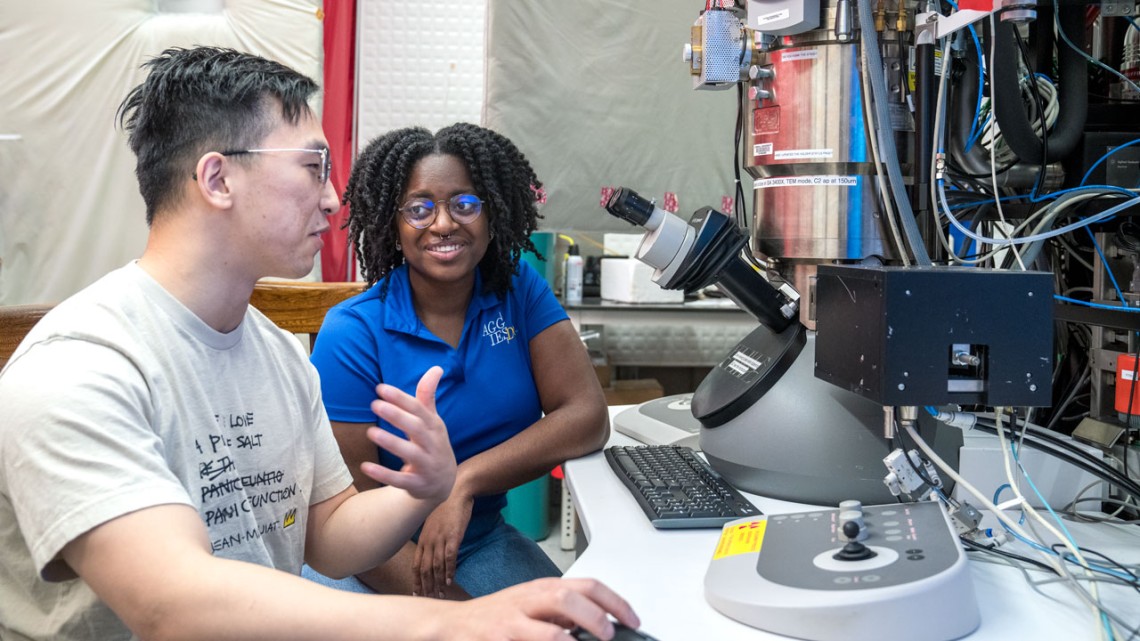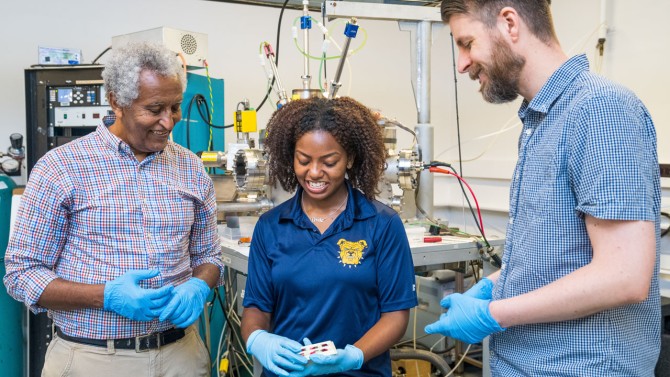
Schuyler Shi, a Cornell doctoral student, and Vanessa Jones, an undergraduate at North Carolina Agricultural and Technical State University, working at a transmission electron microscope in Clark Hall.
‘A better, more equitable future’: program advances diversity and materials science
By J. Edward Anthony
In June, Jacob Som published a paper investigating nickel oxide’s efficacy as an electrocatalyst to produce hydrogen as an energy carrier – research he hopes can help generate sustainable energy solutions for the U.S. as well as his native Ghana.
“This technology is already out there, but it’s costly because the commercial electrocatalysts being used, like platinum, are expensive,” said Som, a doctoral student at North Carolina Agricultural and Technical State University (N.C. A&T) who conducted the research as part of a National Science Foundation-supported collaboration with Cornell. “Our research is trying to develop inexpensive materials to do the same thing. I’m hoping my research paves the way to develop these kinds of technologies and make it more feasible and more accessible to everyone.”
During the past year, students and faculty at Cornell and N.C. A&T have been partnering on a research project built around two shared goals: increasing diversity in the field of materials science and transforming the way the world generates and stores energy.
Collaborative Research and Education in Energy Materials (CREEM) is co-led by Dhananjay Kumar, a professor in N.C. A&T’s Department of Mechanical Engineering and the project’s principal investigator, and Frank Wise, M.S. ’86, Ph.D. ’88, the Samuel B. Eckert Professor in the College of Engineering and director of the Cornell Center for Materials Research (CCMR). The project is funded by a Partnerships for Research in Education and Materials seed grant from the NSF.
“Our collaborations with undergrads, grad students and faculty from N.C. A&T are aimed at building productive relationships and spurring systemic, institutional changes that we must make for a better, more equitable future,” Wise said. “We learn a lot from each other, and this will clearly translate into excellent science and enhanced diversity in materials research.”
N.C. A&T has a long tradition of supporting students of color, and it graduates more African American engineers that any other college or university in the United States. Kumar and his colleagues at N.C. A&T’s College of Engineering have nurtured a thriving research program to explore low-dimensional materials with transformative potential in alternative energy production and storage.
Cornell is a dense hub of materials science expertise and energy technology innovation. CCMR, one of 19 NSF-funded Materials Research Science and Engineering Centers in the country, houses some of the most powerful tools available for developing and testing innovative materials with finely tuned properties, such as the titanium oxynitride thin films that are a focus of CREEM’s efforts.
In October, three doctoral students from Kumar’s lab visited Cornell to learn about the capabilities of CCMR’s facilities and to meet with Cornell faculty and students involved in the collaboration. Now members of Kumar’s lab send materials that they have fabricated at N.C. A&T to their collaborators at Cornell, who characterize the materials using the facilities at CCMR.
“I’ve received so much good data in such a short time,” said Kaushik Sarkar, a doctoral student at N.C. A&T. “We’ve worked with other universities before, but this relationship is different. It feels like a friendship. Cornell is the best partner in the world.”
Schuyler Shi, a Cornell doctoral student who specializes in atomic-resolution electron microscopy, is in frequent communication with Sarkar and other graduate students at N.C. A&T. “This collaboration has taught me how to prepare this nanoarray-structure material for imaging,” Shi says, referring to materials Sarkar has fabricated in pursuit of a non-precious metal alternative for energy storage technologies. “None of our group members has ever worked with these kinds of samples.”
Brooke Smith, an undergraduate student at N.C. A&T, works in Kumar’s lab as part of the collaboration and traveled this summer to Cornell. In the lab of Jin Suntivich, an associate professor of materials science and engineering in Cornell Engineering, Smith developed experiments on ruthenium oxide thin films using CCMR’s sprawling, five-foot tall magnetron sputtering deposition system.
“Really, Brooke taught me sputtering,” said Austin Reese, a Cornell doctoral student who mentored Smith over the summer. “She learned all the ins and outs because I kept asking her questions that I had no clue on, and she’d say, ‘You know, I don't know, either. I'm going to figure that out.’”
Smith presented her findings in regular meetings with Suntivich and other members of her subgroup. “I’ve learned to think like a researcher,” Smith says. “Jin would ask me, ‘Why did you do this?’ And at first I’d say, ‘I don’t know. Because I was told to.’ But he insisted that as a researcher, I shouldn't be afraid to ask questions. ‘You need to ask every question,’ he said. He made me want to be more curious. It has really helped me, because now I am able to explain my project really well.”
Sarkar, Som and a third doctoral student, Manosi Roy, are preparing to defend their thesis projects and graduate this fall.
In May 2023, Smith will finish a five-year dual degree in mathematics and mechanical engineering from Spelman College and N.C. A&T, respectively. She is eager to carry forward the research that she’s immersed herself in this year.
“I want to see how far I can go with thin films,” she said. “It seems like such a cool field. How can something so tiny be used for so many different things? With the knowledge I'm getting from these research experiences, now I’m asking myself, are there other applications? Can I apply this technology to something in our everyday lives that we haven't even thought about? Yes, alternative energy, absolutely! But what else? I want to be a part of that discovery.”
J. Edward Anthony is a writer for the office of the vice president for research and innovation.
Media Contact
Get Cornell news delivered right to your inbox.
Subscribe

